Nursing Asignment Case Study 2022
VerifiedAdded on 2022/09/21
|8
|2424
|30
AI Summary
Contribute Materials
Your contribution can guide someone’s learning journey. Share your
documents today.
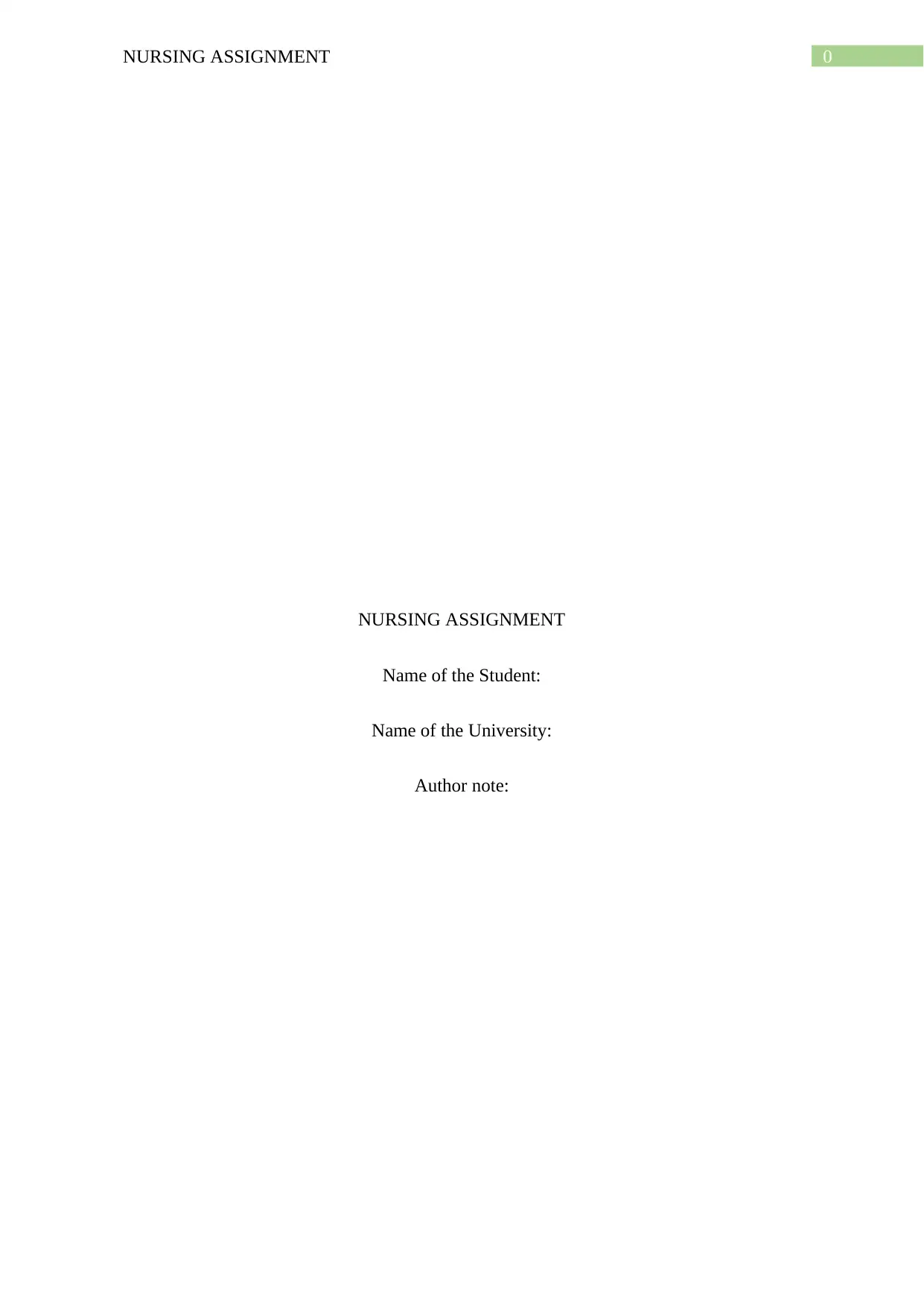
0NURSING ASSIGNMENT
NURSING ASSIGNMENT
Name of the Student:
Name of the University:
Author note:
NURSING ASSIGNMENT
Name of the Student:
Name of the University:
Author note:
Secure Best Marks with AI Grader
Need help grading? Try our AI Grader for instant feedback on your assignments.
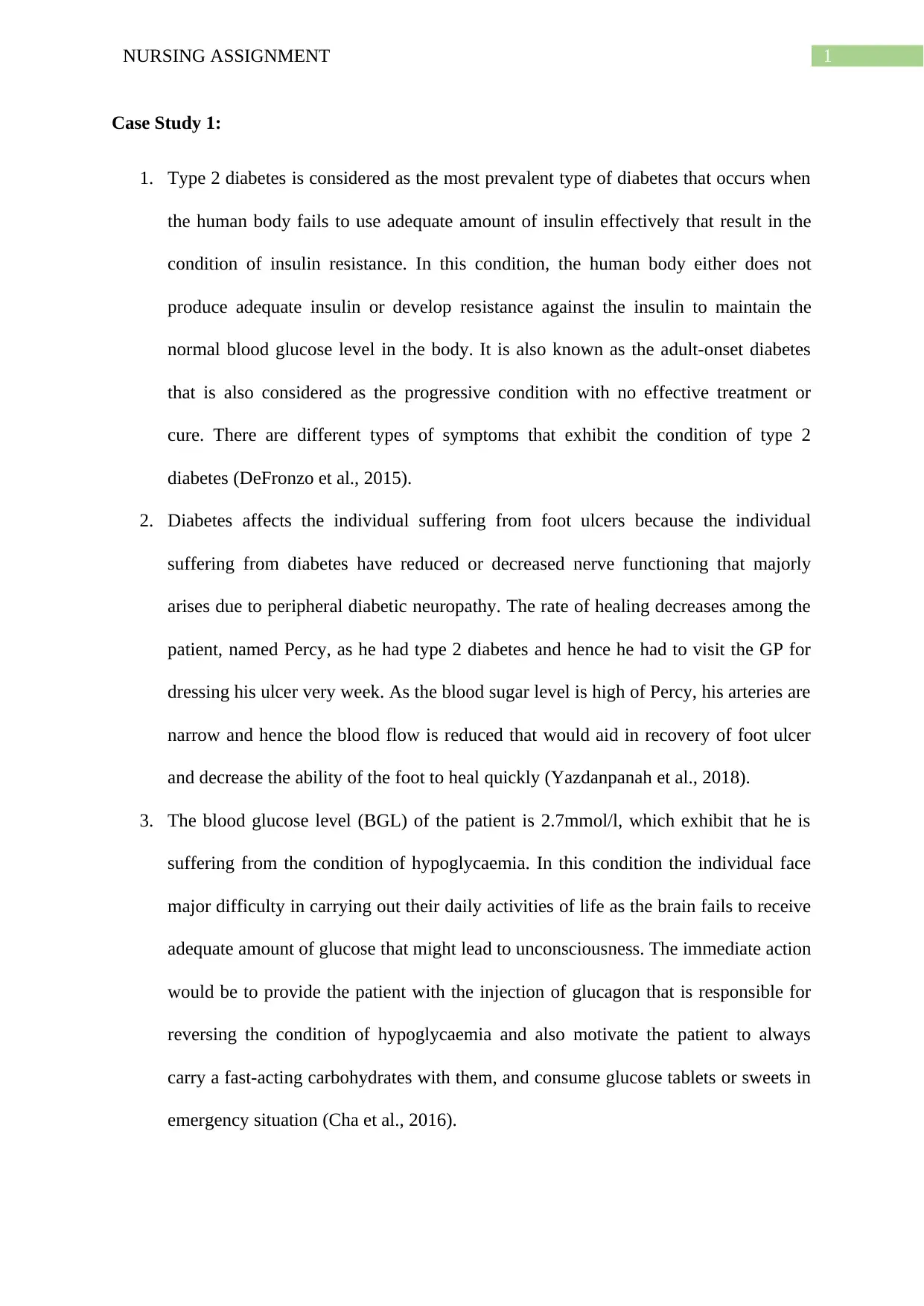
1NURSING ASSIGNMENT
Case Study 1:
1. Type 2 diabetes is considered as the most prevalent type of diabetes that occurs when
the human body fails to use adequate amount of insulin effectively that result in the
condition of insulin resistance. In this condition, the human body either does not
produce adequate insulin or develop resistance against the insulin to maintain the
normal blood glucose level in the body. It is also known as the adult-onset diabetes
that is also considered as the progressive condition with no effective treatment or
cure. There are different types of symptoms that exhibit the condition of type 2
diabetes (DeFronzo et al., 2015).
2. Diabetes affects the individual suffering from foot ulcers because the individual
suffering from diabetes have reduced or decreased nerve functioning that majorly
arises due to peripheral diabetic neuropathy. The rate of healing decreases among the
patient, named Percy, as he had type 2 diabetes and hence he had to visit the GP for
dressing his ulcer very week. As the blood sugar level is high of Percy, his arteries are
narrow and hence the blood flow is reduced that would aid in recovery of foot ulcer
and decrease the ability of the foot to heal quickly (Yazdanpanah et al., 2018).
3. The blood glucose level (BGL) of the patient is 2.7mmol/l, which exhibit that he is
suffering from the condition of hypoglycaemia. In this condition the individual face
major difficulty in carrying out their daily activities of life as the brain fails to receive
adequate amount of glucose that might lead to unconsciousness. The immediate action
would be to provide the patient with the injection of glucagon that is responsible for
reversing the condition of hypoglycaemia and also motivate the patient to always
carry a fast-acting carbohydrates with them, and consume glucose tablets or sweets in
emergency situation (Cha et al., 2016).
Case Study 1:
1. Type 2 diabetes is considered as the most prevalent type of diabetes that occurs when
the human body fails to use adequate amount of insulin effectively that result in the
condition of insulin resistance. In this condition, the human body either does not
produce adequate insulin or develop resistance against the insulin to maintain the
normal blood glucose level in the body. It is also known as the adult-onset diabetes
that is also considered as the progressive condition with no effective treatment or
cure. There are different types of symptoms that exhibit the condition of type 2
diabetes (DeFronzo et al., 2015).
2. Diabetes affects the individual suffering from foot ulcers because the individual
suffering from diabetes have reduced or decreased nerve functioning that majorly
arises due to peripheral diabetic neuropathy. The rate of healing decreases among the
patient, named Percy, as he had type 2 diabetes and hence he had to visit the GP for
dressing his ulcer very week. As the blood sugar level is high of Percy, his arteries are
narrow and hence the blood flow is reduced that would aid in recovery of foot ulcer
and decrease the ability of the foot to heal quickly (Yazdanpanah et al., 2018).
3. The blood glucose level (BGL) of the patient is 2.7mmol/l, which exhibit that he is
suffering from the condition of hypoglycaemia. In this condition the individual face
major difficulty in carrying out their daily activities of life as the brain fails to receive
adequate amount of glucose that might lead to unconsciousness. The immediate action
would be to provide the patient with the injection of glucagon that is responsible for
reversing the condition of hypoglycaemia and also motivate the patient to always
carry a fast-acting carbohydrates with them, and consume glucose tablets or sweets in
emergency situation (Cha et al., 2016).
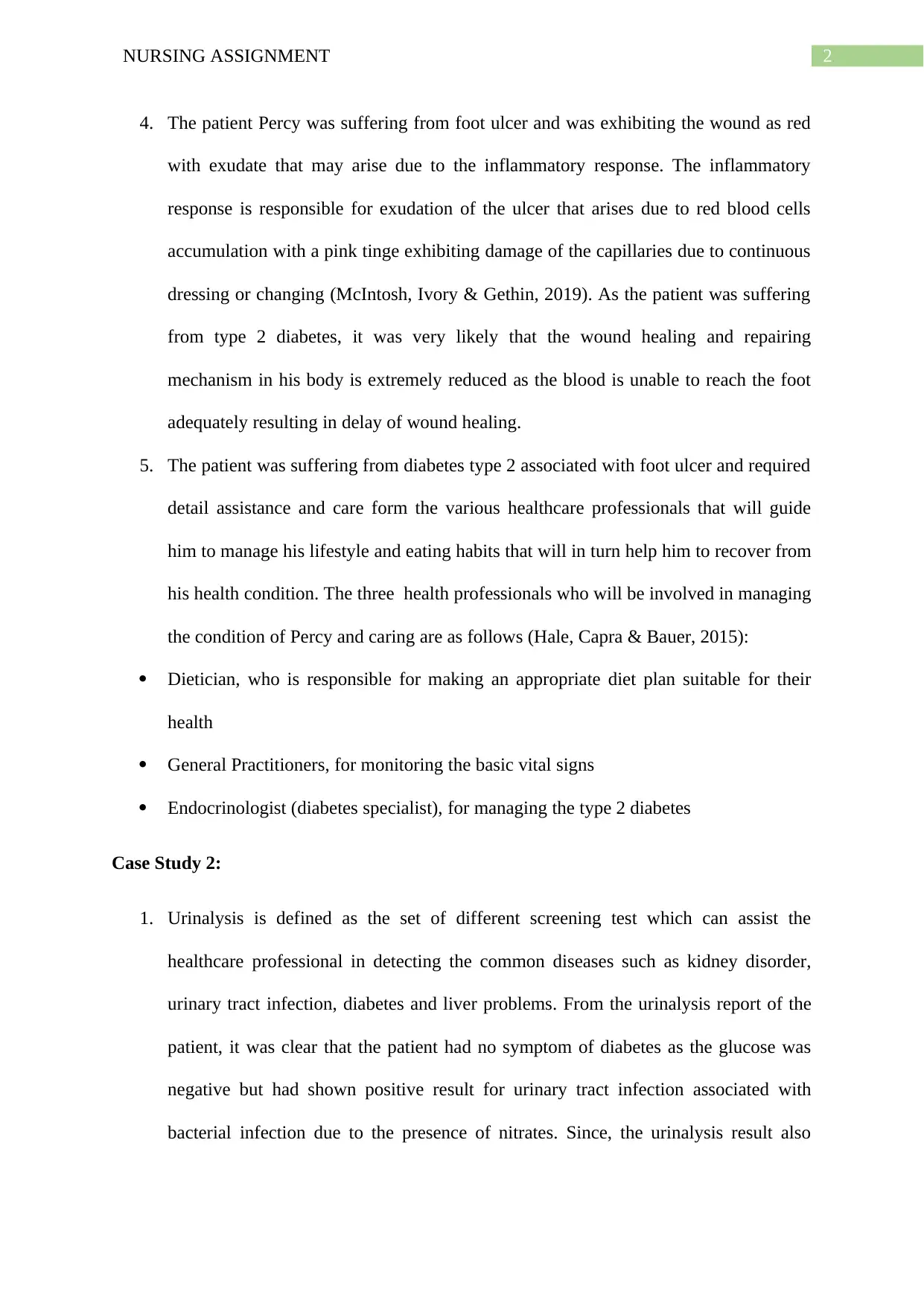
2NURSING ASSIGNMENT
4. The patient Percy was suffering from foot ulcer and was exhibiting the wound as red
with exudate that may arise due to the inflammatory response. The inflammatory
response is responsible for exudation of the ulcer that arises due to red blood cells
accumulation with a pink tinge exhibiting damage of the capillaries due to continuous
dressing or changing (McIntosh, Ivory & Gethin, 2019). As the patient was suffering
from type 2 diabetes, it was very likely that the wound healing and repairing
mechanism in his body is extremely reduced as the blood is unable to reach the foot
adequately resulting in delay of wound healing.
5. The patient was suffering from diabetes type 2 associated with foot ulcer and required
detail assistance and care form the various healthcare professionals that will guide
him to manage his lifestyle and eating habits that will in turn help him to recover from
his health condition. The three health professionals who will be involved in managing
the condition of Percy and caring are as follows (Hale, Capra & Bauer, 2015):
Dietician, who is responsible for making an appropriate diet plan suitable for their
health
General Practitioners, for monitoring the basic vital signs
Endocrinologist (diabetes specialist), for managing the type 2 diabetes
Case Study 2:
1. Urinalysis is defined as the set of different screening test which can assist the
healthcare professional in detecting the common diseases such as kidney disorder,
urinary tract infection, diabetes and liver problems. From the urinalysis report of the
patient, it was clear that the patient had no symptom of diabetes as the glucose was
negative but had shown positive result for urinary tract infection associated with
bacterial infection due to the presence of nitrates. Since, the urinalysis result also
4. The patient Percy was suffering from foot ulcer and was exhibiting the wound as red
with exudate that may arise due to the inflammatory response. The inflammatory
response is responsible for exudation of the ulcer that arises due to red blood cells
accumulation with a pink tinge exhibiting damage of the capillaries due to continuous
dressing or changing (McIntosh, Ivory & Gethin, 2019). As the patient was suffering
from type 2 diabetes, it was very likely that the wound healing and repairing
mechanism in his body is extremely reduced as the blood is unable to reach the foot
adequately resulting in delay of wound healing.
5. The patient was suffering from diabetes type 2 associated with foot ulcer and required
detail assistance and care form the various healthcare professionals that will guide
him to manage his lifestyle and eating habits that will in turn help him to recover from
his health condition. The three health professionals who will be involved in managing
the condition of Percy and caring are as follows (Hale, Capra & Bauer, 2015):
Dietician, who is responsible for making an appropriate diet plan suitable for their
health
General Practitioners, for monitoring the basic vital signs
Endocrinologist (diabetes specialist), for managing the type 2 diabetes
Case Study 2:
1. Urinalysis is defined as the set of different screening test which can assist the
healthcare professional in detecting the common diseases such as kidney disorder,
urinary tract infection, diabetes and liver problems. From the urinalysis report of the
patient, it was clear that the patient had no symptom of diabetes as the glucose was
negative but had shown positive result for urinary tract infection associated with
bacterial infection due to the presence of nitrates. Since, the urinalysis result also
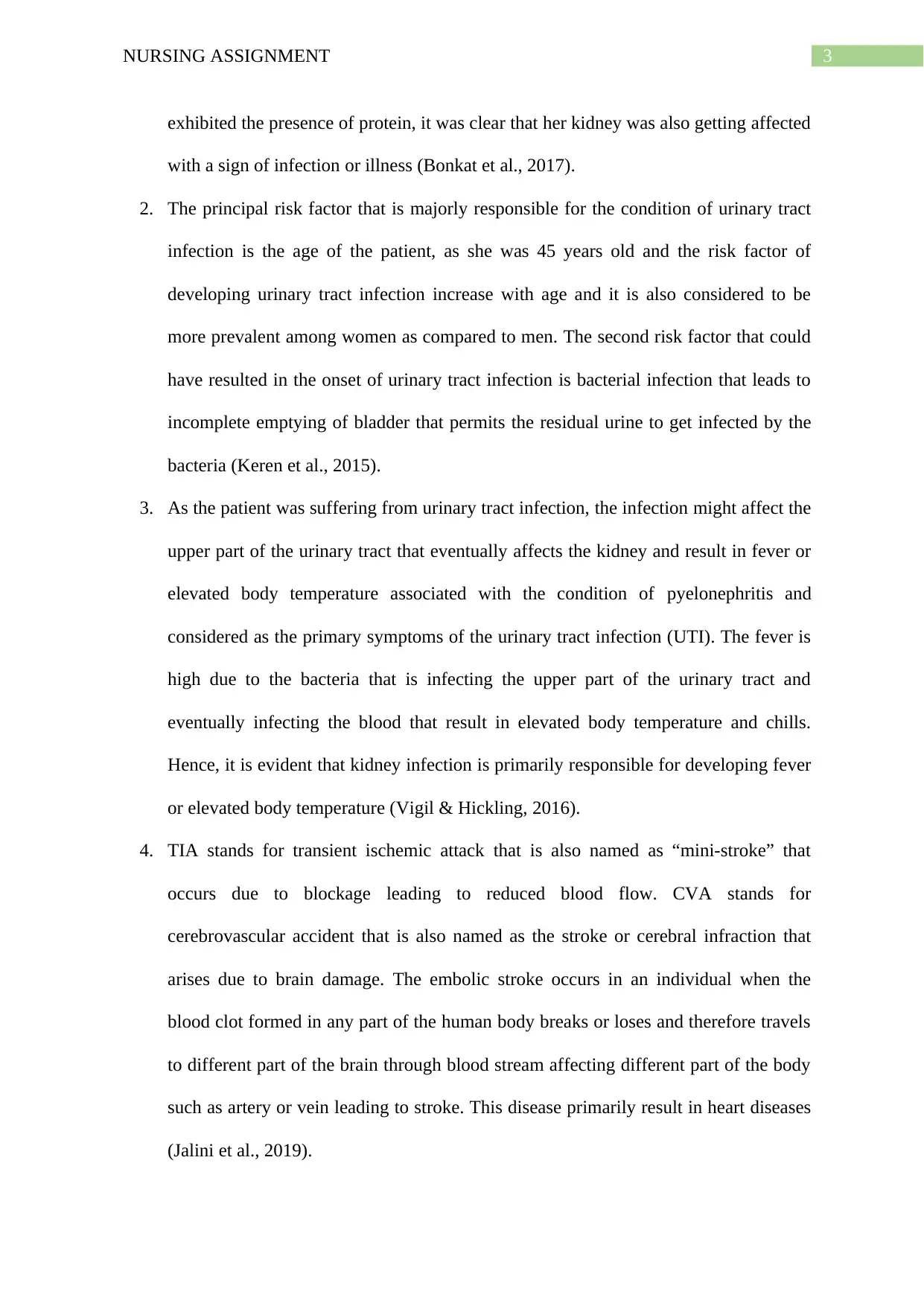
3NURSING ASSIGNMENT
exhibited the presence of protein, it was clear that her kidney was also getting affected
with a sign of infection or illness (Bonkat et al., 2017).
2. The principal risk factor that is majorly responsible for the condition of urinary tract
infection is the age of the patient, as she was 45 years old and the risk factor of
developing urinary tract infection increase with age and it is also considered to be
more prevalent among women as compared to men. The second risk factor that could
have resulted in the onset of urinary tract infection is bacterial infection that leads to
incomplete emptying of bladder that permits the residual urine to get infected by the
bacteria (Keren et al., 2015).
3. As the patient was suffering from urinary tract infection, the infection might affect the
upper part of the urinary tract that eventually affects the kidney and result in fever or
elevated body temperature associated with the condition of pyelonephritis and
considered as the primary symptoms of the urinary tract infection (UTI). The fever is
high due to the bacteria that is infecting the upper part of the urinary tract and
eventually infecting the blood that result in elevated body temperature and chills.
Hence, it is evident that kidney infection is primarily responsible for developing fever
or elevated body temperature (Vigil & Hickling, 2016).
4. TIA stands for transient ischemic attack that is also named as “mini-stroke” that
occurs due to blockage leading to reduced blood flow. CVA stands for
cerebrovascular accident that is also named as the stroke or cerebral infraction that
arises due to brain damage. The embolic stroke occurs in an individual when the
blood clot formed in any part of the human body breaks or loses and therefore travels
to different part of the brain through blood stream affecting different part of the body
such as artery or vein leading to stroke. This disease primarily result in heart diseases
(Jalini et al., 2019).
exhibited the presence of protein, it was clear that her kidney was also getting affected
with a sign of infection or illness (Bonkat et al., 2017).
2. The principal risk factor that is majorly responsible for the condition of urinary tract
infection is the age of the patient, as she was 45 years old and the risk factor of
developing urinary tract infection increase with age and it is also considered to be
more prevalent among women as compared to men. The second risk factor that could
have resulted in the onset of urinary tract infection is bacterial infection that leads to
incomplete emptying of bladder that permits the residual urine to get infected by the
bacteria (Keren et al., 2015).
3. As the patient was suffering from urinary tract infection, the infection might affect the
upper part of the urinary tract that eventually affects the kidney and result in fever or
elevated body temperature associated with the condition of pyelonephritis and
considered as the primary symptoms of the urinary tract infection (UTI). The fever is
high due to the bacteria that is infecting the upper part of the urinary tract and
eventually infecting the blood that result in elevated body temperature and chills.
Hence, it is evident that kidney infection is primarily responsible for developing fever
or elevated body temperature (Vigil & Hickling, 2016).
4. TIA stands for transient ischemic attack that is also named as “mini-stroke” that
occurs due to blockage leading to reduced blood flow. CVA stands for
cerebrovascular accident that is also named as the stroke or cerebral infraction that
arises due to brain damage. The embolic stroke occurs in an individual when the
blood clot formed in any part of the human body breaks or loses and therefore travels
to different part of the brain through blood stream affecting different part of the body
such as artery or vein leading to stroke. This disease primarily result in heart diseases
(Jalini et al., 2019).
Secure Best Marks with AI Grader
Need help grading? Try our AI Grader for instant feedback on your assignments.
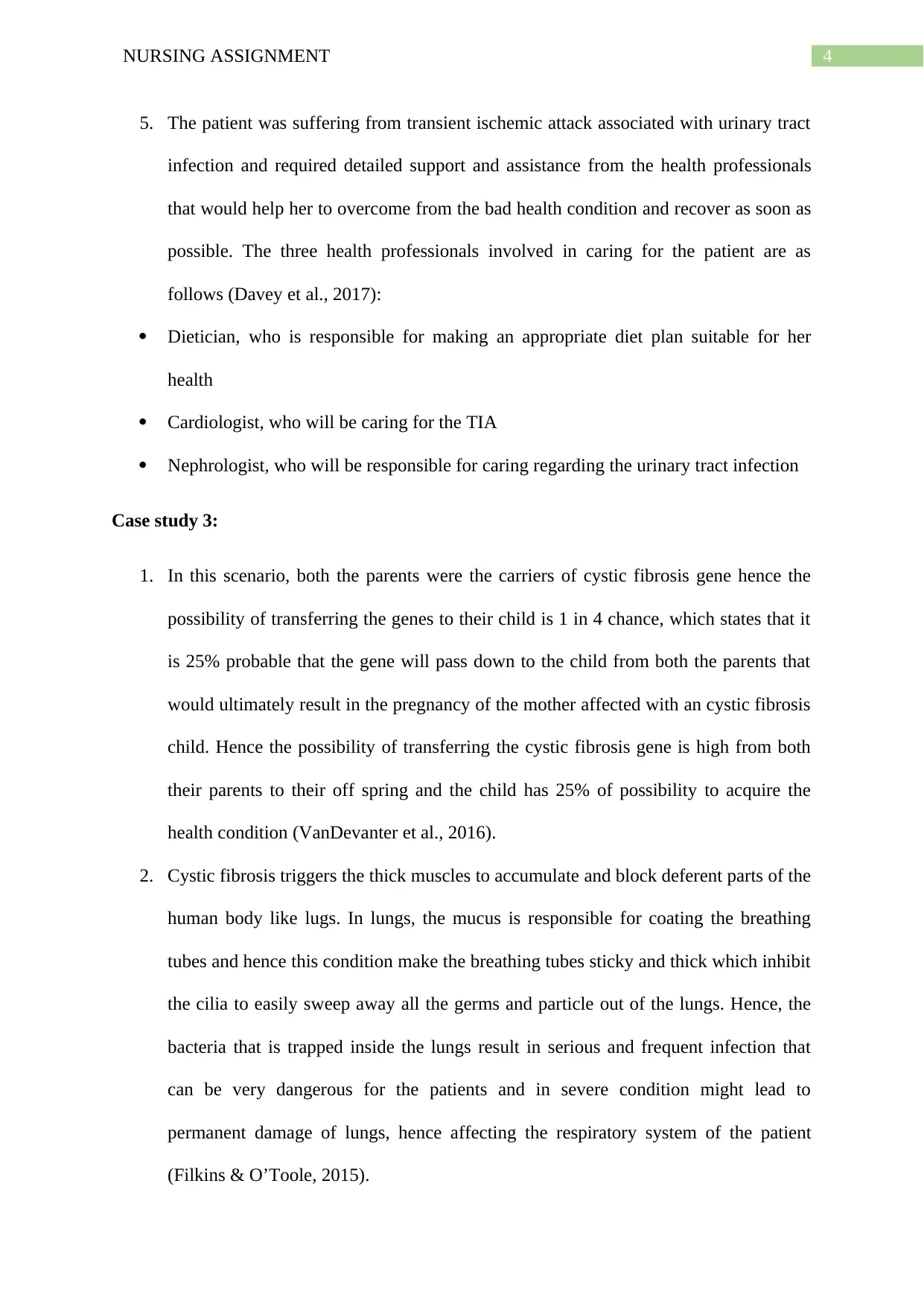
4NURSING ASSIGNMENT
5. The patient was suffering from transient ischemic attack associated with urinary tract
infection and required detailed support and assistance from the health professionals
that would help her to overcome from the bad health condition and recover as soon as
possible. The three health professionals involved in caring for the patient are as
follows (Davey et al., 2017):
Dietician, who is responsible for making an appropriate diet plan suitable for her
health
Cardiologist, who will be caring for the TIA
Nephrologist, who will be responsible for caring regarding the urinary tract infection
Case study 3:
1. In this scenario, both the parents were the carriers of cystic fibrosis gene hence the
possibility of transferring the genes to their child is 1 in 4 chance, which states that it
is 25% probable that the gene will pass down to the child from both the parents that
would ultimately result in the pregnancy of the mother affected with an cystic fibrosis
child. Hence the possibility of transferring the cystic fibrosis gene is high from both
their parents to their off spring and the child has 25% of possibility to acquire the
health condition (VanDevanter et al., 2016).
2. Cystic fibrosis triggers the thick muscles to accumulate and block deferent parts of the
human body like lugs. In lungs, the mucus is responsible for coating the breathing
tubes and hence this condition make the breathing tubes sticky and thick which inhibit
the cilia to easily sweep away all the germs and particle out of the lungs. Hence, the
bacteria that is trapped inside the lungs result in serious and frequent infection that
can be very dangerous for the patients and in severe condition might lead to
permanent damage of lungs, hence affecting the respiratory system of the patient
(Filkins & O’Toole, 2015).
5. The patient was suffering from transient ischemic attack associated with urinary tract
infection and required detailed support and assistance from the health professionals
that would help her to overcome from the bad health condition and recover as soon as
possible. The three health professionals involved in caring for the patient are as
follows (Davey et al., 2017):
Dietician, who is responsible for making an appropriate diet plan suitable for her
health
Cardiologist, who will be caring for the TIA
Nephrologist, who will be responsible for caring regarding the urinary tract infection
Case study 3:
1. In this scenario, both the parents were the carriers of cystic fibrosis gene hence the
possibility of transferring the genes to their child is 1 in 4 chance, which states that it
is 25% probable that the gene will pass down to the child from both the parents that
would ultimately result in the pregnancy of the mother affected with an cystic fibrosis
child. Hence the possibility of transferring the cystic fibrosis gene is high from both
their parents to their off spring and the child has 25% of possibility to acquire the
health condition (VanDevanter et al., 2016).
2. Cystic fibrosis triggers the thick muscles to accumulate and block deferent parts of the
human body like lugs. In lungs, the mucus is responsible for coating the breathing
tubes and hence this condition make the breathing tubes sticky and thick which inhibit
the cilia to easily sweep away all the germs and particle out of the lungs. Hence, the
bacteria that is trapped inside the lungs result in serious and frequent infection that
can be very dangerous for the patients and in severe condition might lead to
permanent damage of lungs, hence affecting the respiratory system of the patient
(Filkins & O’Toole, 2015).
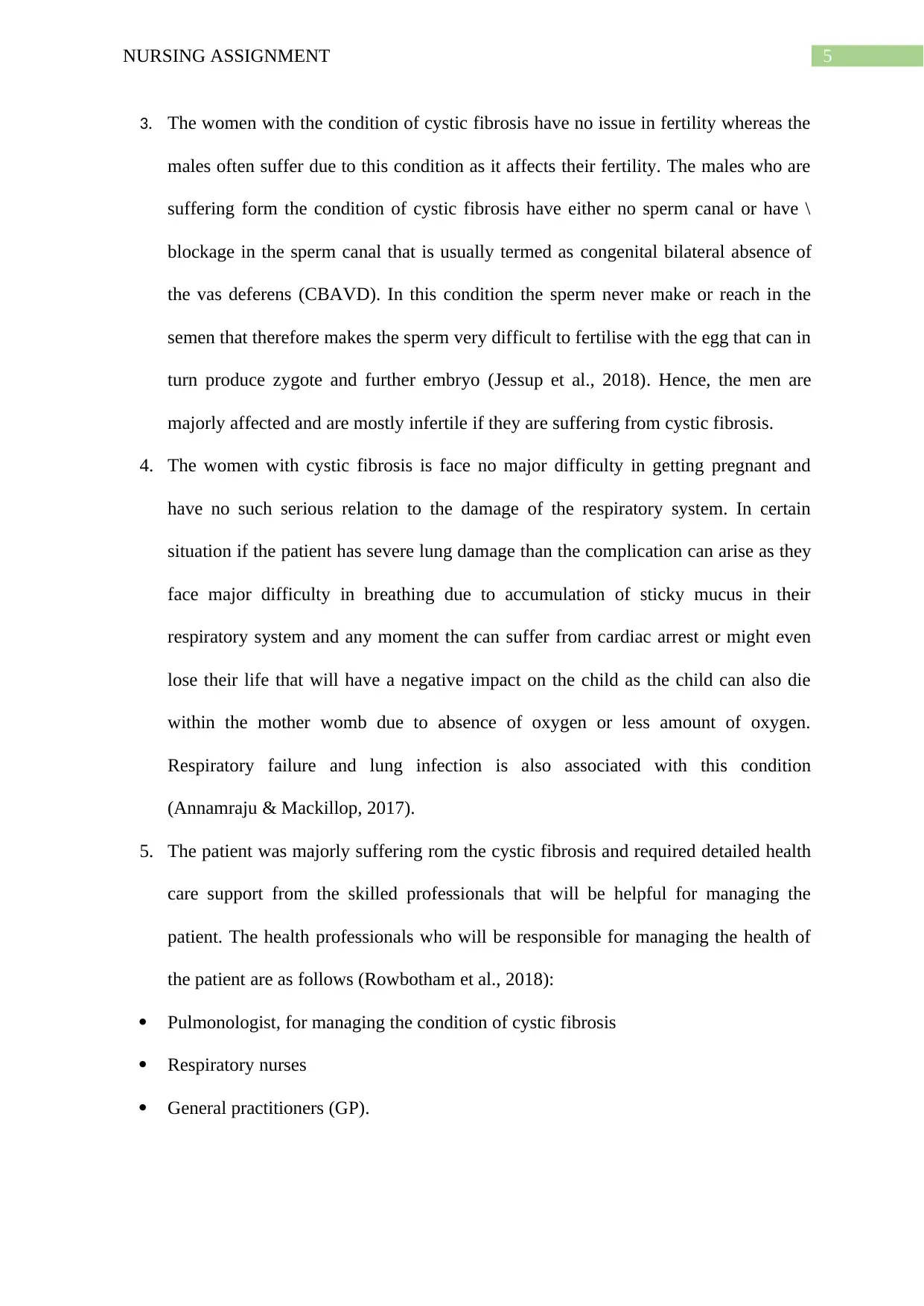
5NURSING ASSIGNMENT
3. The women with the condition of cystic fibrosis have no issue in fertility whereas the
males often suffer due to this condition as it affects their fertility. The males who are
suffering form the condition of cystic fibrosis have either no sperm canal or have \
blockage in the sperm canal that is usually termed as congenital bilateral absence of
the vas deferens (CBAVD). In this condition the sperm never make or reach in the
semen that therefore makes the sperm very difficult to fertilise with the egg that can in
turn produce zygote and further embryo (Jessup et al., 2018). Hence, the men are
majorly affected and are mostly infertile if they are suffering from cystic fibrosis.
4. The women with cystic fibrosis is face no major difficulty in getting pregnant and
have no such serious relation to the damage of the respiratory system. In certain
situation if the patient has severe lung damage than the complication can arise as they
face major difficulty in breathing due to accumulation of sticky mucus in their
respiratory system and any moment the can suffer from cardiac arrest or might even
lose their life that will have a negative impact on the child as the child can also die
within the mother womb due to absence of oxygen or less amount of oxygen.
Respiratory failure and lung infection is also associated with this condition
(Annamraju & Mackillop, 2017).
5. The patient was majorly suffering rom the cystic fibrosis and required detailed health
care support from the skilled professionals that will be helpful for managing the
patient. The health professionals who will be responsible for managing the health of
the patient are as follows (Rowbotham et al., 2018):
Pulmonologist, for managing the condition of cystic fibrosis
Respiratory nurses
General practitioners (GP).
3. The women with the condition of cystic fibrosis have no issue in fertility whereas the
males often suffer due to this condition as it affects their fertility. The males who are
suffering form the condition of cystic fibrosis have either no sperm canal or have \
blockage in the sperm canal that is usually termed as congenital bilateral absence of
the vas deferens (CBAVD). In this condition the sperm never make or reach in the
semen that therefore makes the sperm very difficult to fertilise with the egg that can in
turn produce zygote and further embryo (Jessup et al., 2018). Hence, the men are
majorly affected and are mostly infertile if they are suffering from cystic fibrosis.
4. The women with cystic fibrosis is face no major difficulty in getting pregnant and
have no such serious relation to the damage of the respiratory system. In certain
situation if the patient has severe lung damage than the complication can arise as they
face major difficulty in breathing due to accumulation of sticky mucus in their
respiratory system and any moment the can suffer from cardiac arrest or might even
lose their life that will have a negative impact on the child as the child can also die
within the mother womb due to absence of oxygen or less amount of oxygen.
Respiratory failure and lung infection is also associated with this condition
(Annamraju & Mackillop, 2017).
5. The patient was majorly suffering rom the cystic fibrosis and required detailed health
care support from the skilled professionals that will be helpful for managing the
patient. The health professionals who will be responsible for managing the health of
the patient are as follows (Rowbotham et al., 2018):
Pulmonologist, for managing the condition of cystic fibrosis
Respiratory nurses
General practitioners (GP).
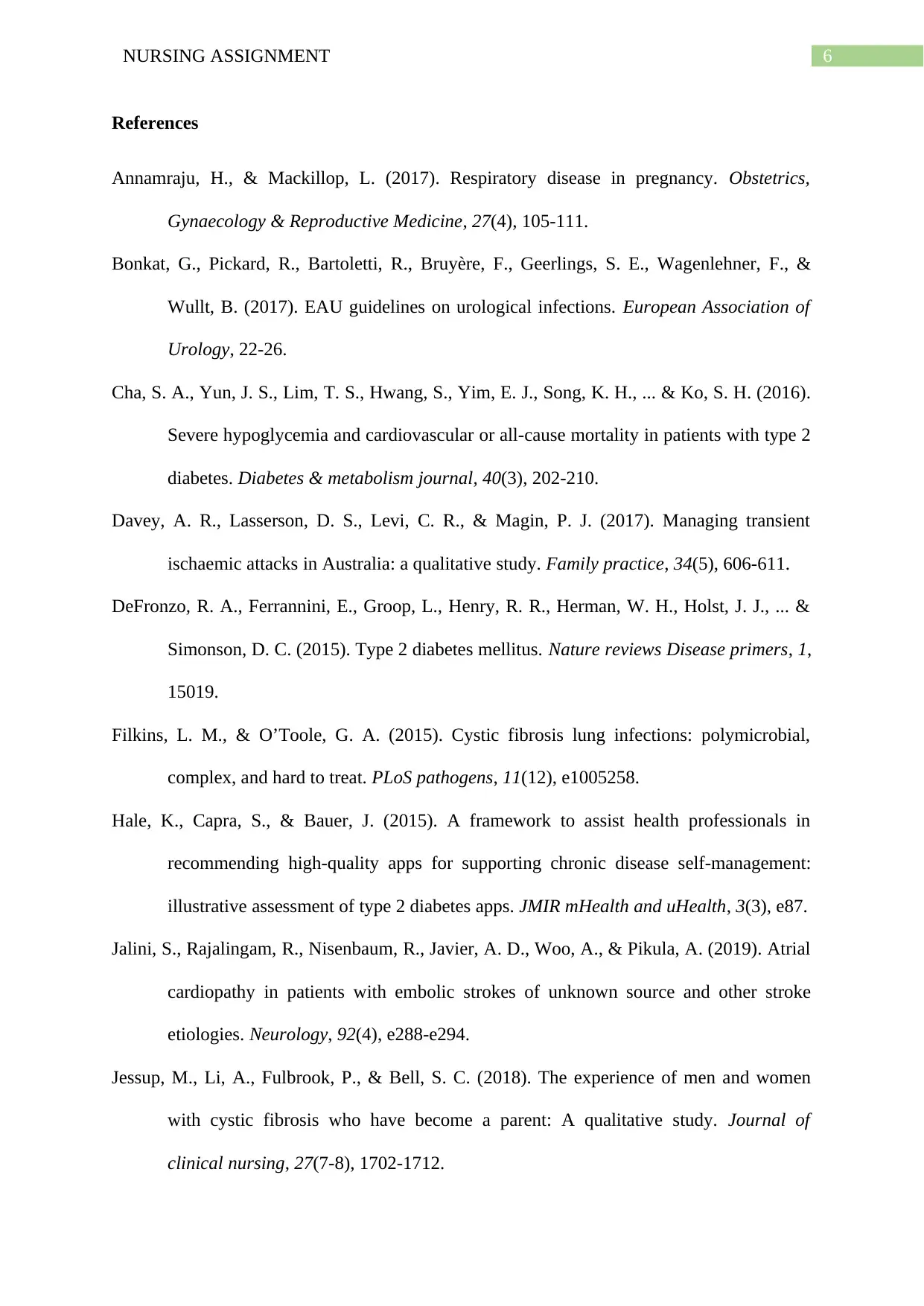
6NURSING ASSIGNMENT
References
Annamraju, H., & Mackillop, L. (2017). Respiratory disease in pregnancy. Obstetrics,
Gynaecology & Reproductive Medicine, 27(4), 105-111.
Bonkat, G., Pickard, R., Bartoletti, R., Bruyère, F., Geerlings, S. E., Wagenlehner, F., &
Wullt, B. (2017). EAU guidelines on urological infections. European Association of
Urology, 22-26.
Cha, S. A., Yun, J. S., Lim, T. S., Hwang, S., Yim, E. J., Song, K. H., ... & Ko, S. H. (2016).
Severe hypoglycemia and cardiovascular or all-cause mortality in patients with type 2
diabetes. Diabetes & metabolism journal, 40(3), 202-210.
Davey, A. R., Lasserson, D. S., Levi, C. R., & Magin, P. J. (2017). Managing transient
ischaemic attacks in Australia: a qualitative study. Family practice, 34(5), 606-611.
DeFronzo, R. A., Ferrannini, E., Groop, L., Henry, R. R., Herman, W. H., Holst, J. J., ... &
Simonson, D. C. (2015). Type 2 diabetes mellitus. Nature reviews Disease primers, 1,
15019.
Filkins, L. M., & O’Toole, G. A. (2015). Cystic fibrosis lung infections: polymicrobial,
complex, and hard to treat. PLoS pathogens, 11(12), e1005258.
Hale, K., Capra, S., & Bauer, J. (2015). A framework to assist health professionals in
recommending high-quality apps for supporting chronic disease self-management:
illustrative assessment of type 2 diabetes apps. JMIR mHealth and uHealth, 3(3), e87.
Jalini, S., Rajalingam, R., Nisenbaum, R., Javier, A. D., Woo, A., & Pikula, A. (2019). Atrial
cardiopathy in patients with embolic strokes of unknown source and other stroke
etiologies. Neurology, 92(4), e288-e294.
Jessup, M., Li, A., Fulbrook, P., & Bell, S. C. (2018). The experience of men and women
with cystic fibrosis who have become a parent: A qualitative study. Journal of
clinical nursing, 27(7-8), 1702-1712.
References
Annamraju, H., & Mackillop, L. (2017). Respiratory disease in pregnancy. Obstetrics,
Gynaecology & Reproductive Medicine, 27(4), 105-111.
Bonkat, G., Pickard, R., Bartoletti, R., Bruyère, F., Geerlings, S. E., Wagenlehner, F., &
Wullt, B. (2017). EAU guidelines on urological infections. European Association of
Urology, 22-26.
Cha, S. A., Yun, J. S., Lim, T. S., Hwang, S., Yim, E. J., Song, K. H., ... & Ko, S. H. (2016).
Severe hypoglycemia and cardiovascular or all-cause mortality in patients with type 2
diabetes. Diabetes & metabolism journal, 40(3), 202-210.
Davey, A. R., Lasserson, D. S., Levi, C. R., & Magin, P. J. (2017). Managing transient
ischaemic attacks in Australia: a qualitative study. Family practice, 34(5), 606-611.
DeFronzo, R. A., Ferrannini, E., Groop, L., Henry, R. R., Herman, W. H., Holst, J. J., ... &
Simonson, D. C. (2015). Type 2 diabetes mellitus. Nature reviews Disease primers, 1,
15019.
Filkins, L. M., & O’Toole, G. A. (2015). Cystic fibrosis lung infections: polymicrobial,
complex, and hard to treat. PLoS pathogens, 11(12), e1005258.
Hale, K., Capra, S., & Bauer, J. (2015). A framework to assist health professionals in
recommending high-quality apps for supporting chronic disease self-management:
illustrative assessment of type 2 diabetes apps. JMIR mHealth and uHealth, 3(3), e87.
Jalini, S., Rajalingam, R., Nisenbaum, R., Javier, A. D., Woo, A., & Pikula, A. (2019). Atrial
cardiopathy in patients with embolic strokes of unknown source and other stroke
etiologies. Neurology, 92(4), e288-e294.
Jessup, M., Li, A., Fulbrook, P., & Bell, S. C. (2018). The experience of men and women
with cystic fibrosis who have become a parent: A qualitative study. Journal of
clinical nursing, 27(7-8), 1702-1712.
Paraphrase This Document
Need a fresh take? Get an instant paraphrase of this document with our AI Paraphraser
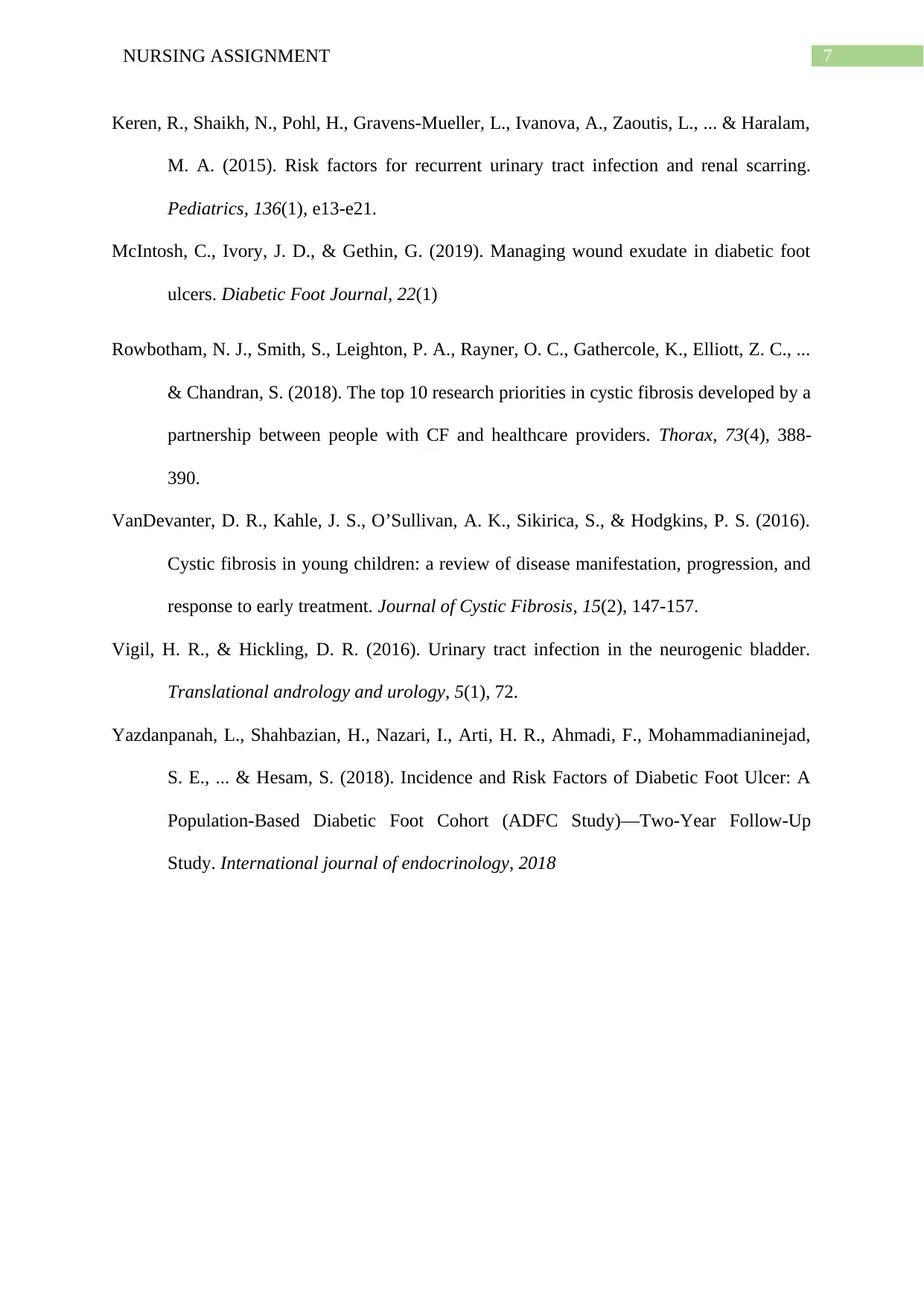
7NURSING ASSIGNMENT
Keren, R., Shaikh, N., Pohl, H., Gravens-Mueller, L., Ivanova, A., Zaoutis, L., ... & Haralam,
M. A. (2015). Risk factors for recurrent urinary tract infection and renal scarring.
Pediatrics, 136(1), e13-e21.
McIntosh, C., Ivory, J. D., & Gethin, G. (2019). Managing wound exudate in diabetic foot
ulcers. Diabetic Foot Journal, 22(1)
Rowbotham, N. J., Smith, S., Leighton, P. A., Rayner, O. C., Gathercole, K., Elliott, Z. C., ...
& Chandran, S. (2018). The top 10 research priorities in cystic fibrosis developed by a
partnership between people with CF and healthcare providers. Thorax, 73(4), 388-
390.
VanDevanter, D. R., Kahle, J. S., O’Sullivan, A. K., Sikirica, S., & Hodgkins, P. S. (2016).
Cystic fibrosis in young children: a review of disease manifestation, progression, and
response to early treatment. Journal of Cystic Fibrosis, 15(2), 147-157.
Vigil, H. R., & Hickling, D. R. (2016). Urinary tract infection in the neurogenic bladder.
Translational andrology and urology, 5(1), 72.
Yazdanpanah, L., Shahbazian, H., Nazari, I., Arti, H. R., Ahmadi, F., Mohammadianinejad,
S. E., ... & Hesam, S. (2018). Incidence and Risk Factors of Diabetic Foot Ulcer: A
Population-Based Diabetic Foot Cohort (ADFC Study)—Two-Year Follow-Up
Study. International journal of endocrinology, 2018
Keren, R., Shaikh, N., Pohl, H., Gravens-Mueller, L., Ivanova, A., Zaoutis, L., ... & Haralam,
M. A. (2015). Risk factors for recurrent urinary tract infection and renal scarring.
Pediatrics, 136(1), e13-e21.
McIntosh, C., Ivory, J. D., & Gethin, G. (2019). Managing wound exudate in diabetic foot
ulcers. Diabetic Foot Journal, 22(1)
Rowbotham, N. J., Smith, S., Leighton, P. A., Rayner, O. C., Gathercole, K., Elliott, Z. C., ...
& Chandran, S. (2018). The top 10 research priorities in cystic fibrosis developed by a
partnership between people with CF and healthcare providers. Thorax, 73(4), 388-
390.
VanDevanter, D. R., Kahle, J. S., O’Sullivan, A. K., Sikirica, S., & Hodgkins, P. S. (2016).
Cystic fibrosis in young children: a review of disease manifestation, progression, and
response to early treatment. Journal of Cystic Fibrosis, 15(2), 147-157.
Vigil, H. R., & Hickling, D. R. (2016). Urinary tract infection in the neurogenic bladder.
Translational andrology and urology, 5(1), 72.
Yazdanpanah, L., Shahbazian, H., Nazari, I., Arti, H. R., Ahmadi, F., Mohammadianinejad,
S. E., ... & Hesam, S. (2018). Incidence and Risk Factors of Diabetic Foot Ulcer: A
Population-Based Diabetic Foot Cohort (ADFC Study)—Two-Year Follow-Up
Study. International journal of endocrinology, 2018
1 out of 8
Related Documents
Your All-in-One AI-Powered Toolkit for Academic Success.
+13062052269
info@desklib.com
Available 24*7 on WhatsApp / Email
![[object Object]](/_next/static/media/star-bottom.7253800d.svg)
Unlock your academic potential
© 2024 | Zucol Services PVT LTD | All rights reserved.





